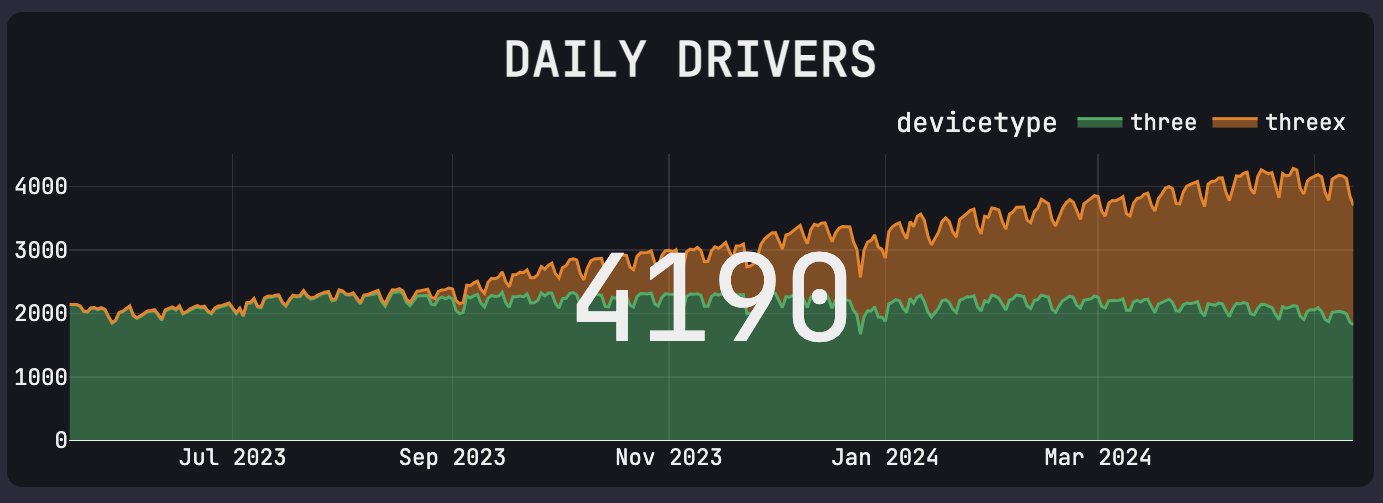Refactoring for Growth
In 2020, we announced the unconjoined triangle of success made up of the research, openpilot, and operations teams. Over the last four years, those teams shipped two products, a robotics platform, 3 major and 30 minor openpilot releases, the first end-to-end driving agent, and a drive to Taco Bell without a disengagement.
As the company has grown, it’s time to refactor things a bit. Remember that our mission is to:
Solve self-driving cars while delivering shippable intermediaries.
comma is fundamentally a consumer electronics company that ships the latest AI to you as a product. Consumer electronics is a good business to be in; we’re building products that we’d like to buy, and it allows us to build in the open.
The New Triangle

The operations team is in charge of company infrastructure. This includes money, people, logistics, the comma fleet, and keeping everything running.
The product team designs and manufactures the product. This includes the hardware, low level software needed to run the autonomous agent software, as well the app.
The autonomy team is responsible for making the autonomous agent software, and all of the infrastructure needed for that.
The operations and product teams work together to ship you the comma 3X, and the autonomy and product teams ship openpilot to run on your comma 3X.
Let’s take a look at where we’re at now
comma is a 21 person company made up of mostly engineers, and we build and ship all our hardware and software from our San Diego, CA office.
We’re shipping openpilot 0.9.7, with 54% of miles and 29% of time engaged.

We’re shipping comma 3Xs to a growing fleet, where every comma 3X sold makes us money.

This is our MY700 jetting a comma 3X panel. We’re scaling up the factory to output 10x more devices.
What’s next?
It should be clear now that widespread deployment of driverless cars is still years away. Meanwhile, openpilot’s partial autonomy improves driving on 10 million compatible cars currently on the road, with more sold every day.
With user growth on a product that’s profitable and machine learning simulation working, the path forward is clear:
- Drive down disengagements with our new simulator
- Improve the product until it looks like something you can buy at Best Buy and drive out of the parking lot with
- Scale up production until we have a lights-out factory
Join Us
We’re growing the team by ~5 people to help solve autonomy, improve the product, and scale up production. You’ll hear more about each team in the following posts from the head of each team.
Check out our new leaderboard and jobs page. It’s got some fun programming challenges that also happen to be hiring challenges.
FAQ
> If the software is open source, how will comma make money?
We sell a hardware product and offer a (very optional) software subscription.
And we’re already making money. We last raised money two years ago, and since then, have been profitable from sales in our shop.
> Why open source the software at all?
We like working on open source projects, and it leaves no room for rent seeking.
> If the software is open source, won’t there be clones?
Like forks of openpilot, clones grow the ecosystem. The openpilot software and hardware ecosystem has grown well beyond us, and we’ll continue to do fine as long as we offer a good product for a fair price.
> What happens when cars ship with openpilot-quality ADAS?
Have the auto manufacturers even shipped you a CarPlay-level infotainment system? How about OTA updates?
> Why not partner with the car companies?
The quality of the product is currently the bottleneck for getting openpilot in more cars. And it’s not clear that they can give us better interfaces to the car than opendbc.
Cars will eventually ship with openpilot, but it remains to be seen how this plays out. Maybe a Tier 1 will do it for the existing manufacturers, or perhaps some new manufacturer will be the first.

Leave a comment